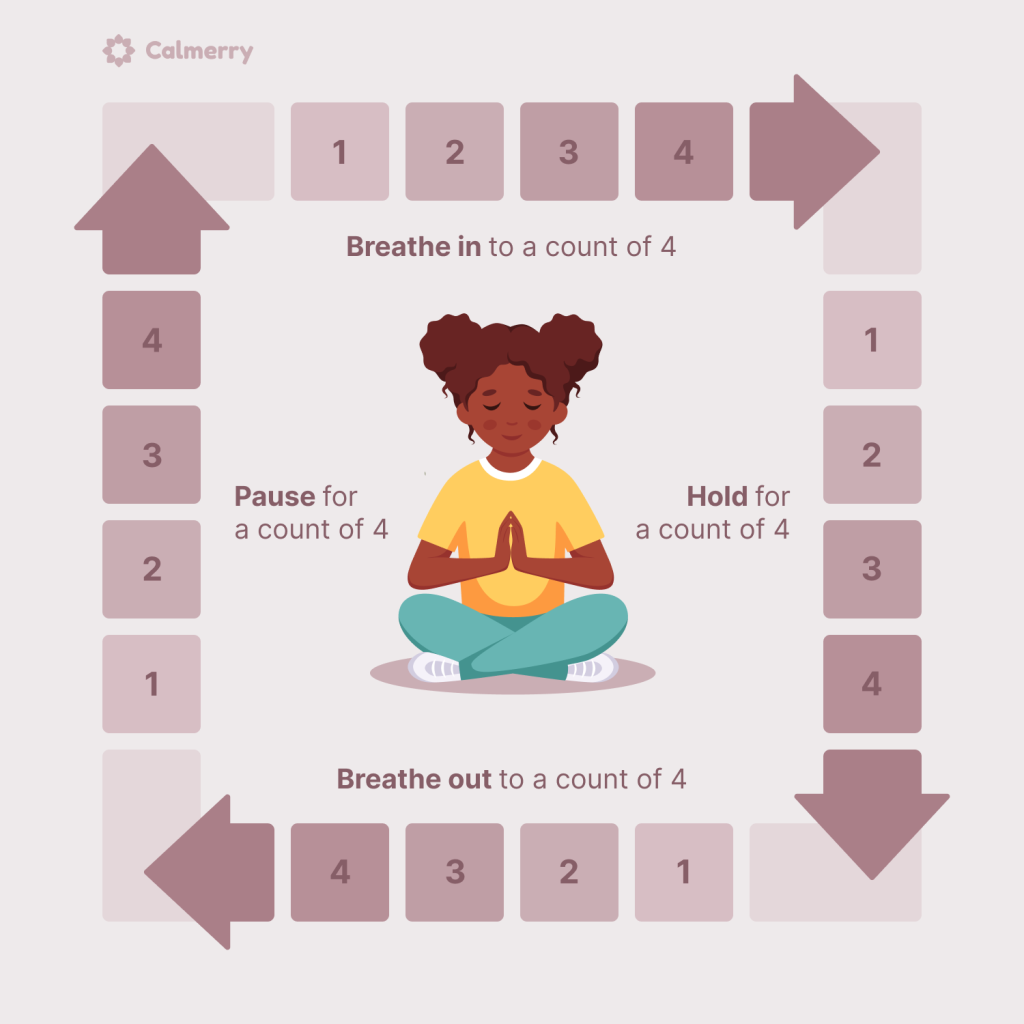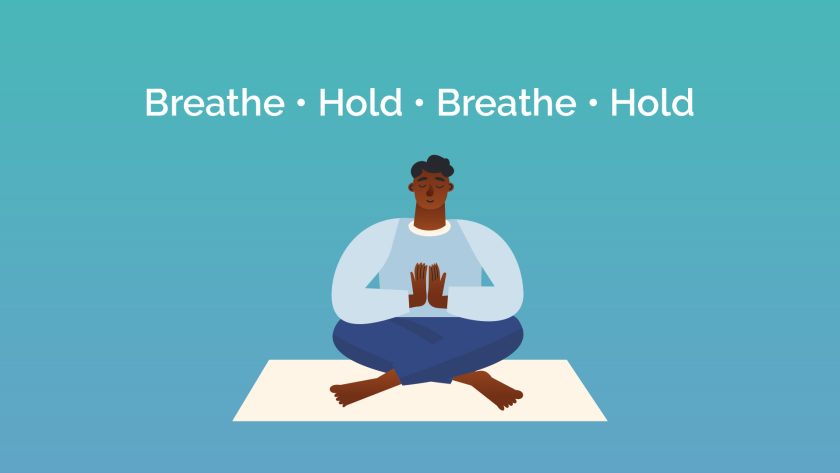Focusing on breath during heightened alertness reduces stress, calms anxiety, and develops mindfulness. There are different breathing exercises that you can keep in your toolbox when you need them, and one basic breathing technique is called box breathing.
Although intentionally slowing down your breathing may seem new, it has ancient Ayurvedic roots. Box breathing has been used for thousands of years. Even Navy SEALs use it to stay calm and focus in high-stress, high-pressure situations.
You don’t have to be a yogi or Navy SEAL to practice it. You can do it independently. This simple four-step breathing technique is more straightforward and can be done anytime, anywhere.
Also Read: 20+ Louise Hay Affirmations To Keep Your Mind Calm
In this article, we’ll walk through the four easy steps you need to take to learn box breathing and explore other deep breathing techniques.
What is the Box breathing Method?
Box breathing is a powerful yet simple relaxation technique designed to bring your breathing back to its normal rhythm after experiencing stress. It can help clear the mind, relax the body, and improve concentration. It consists of four basic steps, each lasting 4 seconds:

- Inhaling
- Holding the breath
- Exhaling
- Hold your breath and repeat
It is also known as square breathing, 4 4 4 technique, four-count breathing, sama vritti pranayama, tactical breathing, or yogic breathing.
Box breathing is generally used by people with stressful jobs, such as soldiers and police officers, when their bodies are in fight-or-flight mode. But this doesn’t mean you can’t use it. The technique is suitable for anyone looking to refocus or improve concentration.
If you’re new to box breathing, it can be challenging to get the hang of it. Also, after a few rounds, you might feel dizzy. If it is unbearable, sit for a minute and resume normal breathing. The more you practice, the longer you can go without feeling dizzy.
To start with box breathing, find a quiet, dimly lit area to practice. Once you start practicing the technique, you can stay focused longer. In one session, you must repeat the box breathing cycle four times.
Box breathing makes breathing slower and deeper, making your brain focus and aware of your breath. During times of stress, when practiced, it helps. It is also beneficial as a daily habit.
Benefits of box breathing
Breathing exercises are simple, can be done anywhere, and have a powerful effect on physiology. When you’re anxious or stressed, your body prepares itself as if it’s in danger. Your heart rate and blood pressure increase, your muscles tighten, and your breathing becomes shallow. Some people may experience shortness of breath, making them more anxious.
Box breathing helps counteract the stress response by eliciting a relaxation response. As breathing deepens, heart rate slows, muscles relax, and blood pressure drops or stabilizes.
A 2023 study of breathing exercises, including box breathing, showed that 5 minutes a day of breathing exercises can reduce anxiety and improve mood.
Other research suggests box breathing may help:
Relieve pressure
The biggest benefit of box breathing is relaxation, especially during stressful times. Research shows that regulating your breathing can reduce levels of the stress hormone cortisol and may even help lower blood pressure.
Activates the parasympathetic nervous system
During times of stress, your sympathetic nervous system is on high alert. Box breathing can help you out of this state. The parasympathetic nervous system is the opposite of the sympathetic nervous system, also known as “fight or flight.”
When we’re scared, we breathe shallowly and fast, which creates more anxiety in our bodies. Focusing on breathing can help us get out of the fight-or-flight state and think straight.
Peace of mind|
You don’t have to feel stressed to benefit from this breathing exercise. Practicing box breathing is an opportunity to bring mindfulness into your breath, and it can be a valuable practice even in quiet times.
Reduces the body’s stress response.
Big, deep, gentle breaths that fill your belly can counteract stress’s physical and mental elements. Deep breathing reduces the physiological consequences of stress in adults.
When you’re stressed or tense, one of the ways your system responds is by making your breathing faster and shallower. This rapid breathing, also known as hyperventilation—essentially exhaling more than inhaling—can lower carbon dioxide levels in the body and cause dizziness. Slowing your breathing helps control hyperventilation. It restores your breathing rhythm and corrects the fast, shallow breathing associated with stress and anxiety.
Stop unhelpful thought loops.
Box breathing has vast benefits for calming the mind. Stress and anxiety often accompany a head full of thoughts. When you do box breathing, it helps the mind focus and reduces stress. When thoughts spin non-stop, stopping them feels impossible. With mindfulness-based breathing exercises like box breathing, you turn your attention to other things than disturbing, overwhelming, or just plain negative thoughts. It frees your brain to have other things to focus on.
The more you practice box breathing, the more your brain can turn its attention away from useless thought chitchat. This is a skill that you can learn through practice.
Helps you focus on the present moment.
Anxiety is usually worrying about the future or avoiding the past. Box breathing is closely related to meditation and mindfulness, two of the best techniques for grounding yourself in the present moment.
Focusing on the breath lets you become very present, helping you avoid falling into unhelpful thought patterns.
How do you try box breathing on your own?
This breathing exercise is easy to start. You don’t need any special equipment, not even a remote location, just your thoughts and your breath. Try it when you’re stressed or regularly to promote relaxation.
To practice it, follow these steps:
- Ground yourself (e.g., sit in a chair, sit on the floor, and stand comfortably).
- Sit or stand straight (but not stiff) and relax your shoulders.
- Focus on your breathing.
- As you count to four, take slow, deep breaths and hold the inhale for a count of four.
- Feel your stomach expand with air.
- Hold your breath for four counts. Just remember to count to four.
- Exhale through your mouth: Exhale four times evenly, making every fourth exhalation last.
- Hold the button again for another count of four.
- Repeat this cycle as necessary.
Why breathing is essential to health
Working to get your breath out of “fight or flight” mode is good for both the mind and body.
The autonomic nervous system refers to functions that occur without thought, such as the heart’s beating or the digestion of food. This system can be in a fight or flight or rest and digest state.
In fight-or-flight mode, the body senses a threat and responds to help the person escape or avoid the threatening situation. The body releases hormones such as epinephrine and norepinephrine. These trigger a cascade of reactions, including increased heartbeat, breathing, and blood sugar levels. To deal with such physical and psychological effects, paying attention to breathing is necessary.
Keep practicing
At first, you may find it challenging to breathe peacefully. But, like anything, you can improve it with some practice. If you practice box breathing in quiet times, you can use it in times of anxiety and even lower your body’s overall response to stress.
Box breathing is a simple technique that can help calm the mind and body during times of stress. Research shows that it may also help relieve symptoms of anxiety and depression and improve alertness and cognitive performance.




